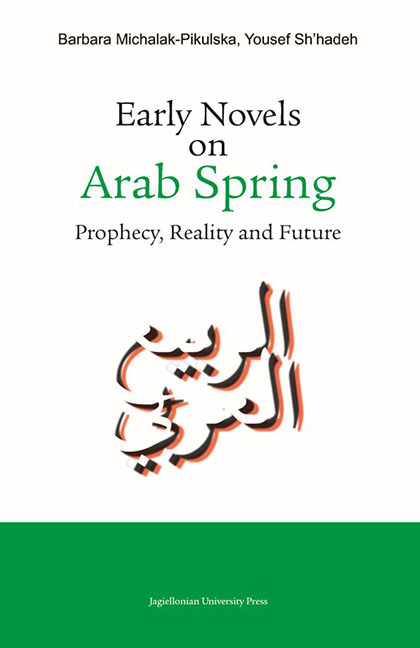Book contents
- Frontmatter
- Contents
- Introduction
- Part I Awakening of the Awareness of Subjugation – The Prophecy of the Spring of Nations in Arab Novels
- Part II At the Heart of the Arab Spring Events
- Part III The Future: The Spring Continues
- 17 Mu‘Taṣim Aš - Šā‘Ir : Uhzūǧat ar-raḥīl (A Song of Departure) and Fī intiẓār as-sulaḥfāt (Waiting for a Turtle)
- 18 Aḥmad ‘Abd Al - Malik : Al-Aqni‘a (Masks)
- 19 Ṭayba Aš - Šarīf Al - Idrīsī : Ḥaǧar min saqar (A Stone from Hell)
- 20 Amīra Aš - Širbīnī : ‘Itq (Liberation)
- 21 ‘ Izz Ad - Dīn Šukrī Fašīr : Bāb al-ẖurūǧ – risālat ‘Alī al-muf‘ama bi-bahǧa ġayr mutawaqqa‘a (The Gate to Leave – Ali’s Letter Filled with Unexpected Joy)
- Conclusion
- Bibliography
- Summary in Arabic
14 - Muḥammad Saʻīd Ar - Rīḥānī : ‘Aduww aš-šams – al-bahlawān al-laḏī ṣāra waḥšan (The Enemy of the Sun – A Clown Who Has Become a Beast)
Published online by Cambridge University Press: 13 October 2023
- Frontmatter
- Contents
- Introduction
- Part I Awakening of the Awareness of Subjugation – The Prophecy of the Spring of Nations in Arab Novels
- Part II At the Heart of the Arab Spring Events
- Part III The Future: The Spring Continues
- 17 Mu‘Taṣim Aš - Šā‘Ir : Uhzūǧat ar-raḥīl (A Song of Departure) and Fī intiẓār as-sulaḥfāt (Waiting for a Turtle)
- 18 Aḥmad ‘Abd Al - Malik : Al-Aqni‘a (Masks)
- 19 Ṭayba Aš - Šarīf Al - Idrīsī : Ḥaǧar min saqar (A Stone from Hell)
- 20 Amīra Aš - Širbīnī : ‘Itq (Liberation)
- 21 ‘ Izz Ad - Dīn Šukrī Fašīr : Bāb al-ẖurūǧ – risālat ‘Alī al-muf‘ama bi-bahǧa ġayr mutawaqqa‘a (The Gate to Leave – Ali’s Letter Filled with Unexpected Joy)
- Conclusion
- Bibliography
- Summary in Arabic
Summary
Every regime in its purest form is simply ideology communicated by means of propaganda and people who do not consent to its ways are ideologically and physically destroyed by it. In this system, a person can be imprisoned or murdered at any time. Literature’s obligation in such circumstances is to reveal the mechanisms of regimes and the crimes committed in their name. Showing the hounded and harried man; upholding the value of human dignity in the face of fear of torture and death. The work was written as a testimony to the Libyan revolution and according to the information presented on its title page, it was hailed as the first novel about its course. The time of the action covers the period from February to November 2011, and the work is a kind of psychological portrait of Muammar Gaddafi and shows his sick personality and behavior during that time. It is an example of the perversion of any power that forgets the ideals that were supposed to guide it. Dictators believe in their infallibility and their merits, hence the privileges which they demand. In the introduction to his novel, ‘Aduww aš-šams – al-bahlawān al-laḏī ṣāra waḥšan (The Enemy of the Sun – A Clown Who Has Become a Beast), Muḥammad Saʻīd ar-Rīḥānī writes that: “The work is a tragicomedy about a soldier who is looking for a cure for his mental illness manifesting in the constant feeling of the urge to hold power in his hands.” Further in the work, the author presents a satirized image of Gaddafi and his unbalanced behavior.
It is hard to consider this work as a novel, not only because the text is only sixty-three pages long, but also because it focuses on only one hero and is actually devoid of a typical story line. The work is not accidentally composed of eleven short chapters. The author wanted to draw the reader’s attention to the number eleven; he mentions this in the introduction: “Dividing the novel into eleven chapters goes hand in hand with 2011 – the year of the Arab Spring.
- Type
- Chapter
- Information
- Early Novels on Arab SpringProphecy, Reality and Future, pp. 97 - 104Publisher: Jagiellonian University PressPrint publication year: 2022

